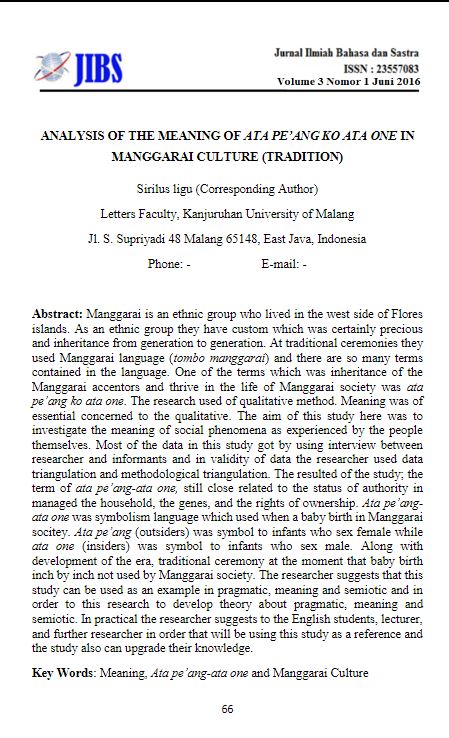ANALYSIS OF THE MEANING OF ATA PE’ANG KO ATA ONE IN MANGGARAI CULTURE (TRADITION)
Main Article Content
Abstract
Manggarai is an ethnic group who lived in the west side of Flores islands. As an ethnic group they have custom which was certainly precious and inheritance from generation to generation. At traditional ceremonies they used Manggarai language (tombo manggarai) and there are so many terms contained in the language. One of the terms which was inheritance of the Manggarai accentors and thrive in the life of Manggarai society was ata pe’ang ko ata one. The research used of qualitative method. Meaning was of essential concerned to the qualitative. The aim of this study here was to investigate the meaning of social phenomena as experienced by the people themselves. Most of the data in this study got by using interview between researcher and informants and in validity of data the researcher used data triangulation and methodological triangulation. The resulted of the study; the term of ata pe’ang-ata one, still close related to the status of authority in managed the household, the genes, and the rights of ownership. Ata pe’ang-ata one was symbolism language which used when a baby birth in Manggarai socitey. Ata pe’ang (outsiders) was symbol to infants who sex female while ata one (insiders) was symbol to infants who sex male. Along with development of the era, traditional ceremony at the moment that baby birth inch by inch not used by Manggarai society. The researcher suggests that this study can be used as an example in pragmatic, meaning and semiotic and in order to this research to develop theory about pragmatic, meaning and semiotic. In practical the researcher suggests to the English students, lecturer, and further researcher in order that will be using this study as a reference and the study also can upgrade their knowledge.
Article Details
JIBS (Jurnal Ilmiah Bahasa dan Sastra) allows readers to read, download, copy, distribute, print, search, or link to the full texts of its articles and allow readers to use them for any other lawful purpose. The journal allows the author(s) to hold the copyright without restrictions. Finally, the journal allows the author(s) to retain publishing rights without restrictions

This work is licensed under a Creative Commons Attribution-ShareAlike 2.0 Generic License.
References
Soekanto, S. 2012. Sosiologi: Suatu pengantar. Jakarta: Rajawali Pers
Nggoro, M. A. 2006. Budaya Manggarai: Selayang Pandang. Ende: Nusa Indah
Dagur, B. A. 1997. Kebudayaan Manggarai: Sebagai Salah Satu Khasanah Kebudayaan Nasional. Surabaya: Ubhara Press
Deki, T. K. 2011. Tradisi Lisan Orang Manggarai: Membidik persaudaraan dalam bingkai sastra. Jakarta: Parhesia Institute Jakarta
Manning, K. P. (1987). Semiotics and fieldwork. Newbury Park, Cal.: Sage.
Oxford. (2015). Oxford Dictionaries: Language matters. English: Oxford University Press
Riley, Philip. 2007. Language, Culture and identity: An Ethnolinguistic Perspective. Great Britain: Athenaeum Press Ltd.,
Elmes. D. The Relationship between Language and Culture. National Institute of Fitnessand Sports in Kanoya International Exchange and Language Education Center
Kreidler w. K. 1998. Introduction English: Semantics. London: Routledge
Adisutrisno W. D. 2008. Semantics: an introduction to the basic concepts. Yogyakarta: ANDI
Ayu P. N. Konsep hidup dan mati dalam leksikon khaul buyut tambi (kajian etnolinguistik di indramayu). Jurnal: Universitas Pendidikan Indonesia
Qudus. R. 2013. Analisis kohesi leksikal dalam novel dom sumurup ing banyu karya suparto brata. Jurnal: Program Studi Pendidikan Bahasa dan Sastra Jawa_Universitas Muhammadiyah Purworejo 83
Pratiknyo. A. 2009. Istilah-istilah upacara perkawinan adat jawa bubak kawah dan tumplak punjen di kecamatan bendosari kabupaten sukoharjo (suatu kajian etnolinguistik). Skripsi: universitas Sebelas Maret Surakarta
Wahyuni, S. 2011. Qualitative Research Method: Theory and Practice. Jakarta: Penerbit Salemba
Mitchell, M. (2008). Conducting ethnographic research on language-like visual Communication. Bond University: Faculty of Humanities and Social Sciences
Creswell, W. J. 2003. Research Design: Qualitative,Quantitative, and Mixed Methods Approaches. USA: Copyright O 2003 by Sage Publications, Inc
Miles, B. M. and Huberman, M. A. 1994. Qualitative Data Analysis.USA: Sage Publications, Inc
Denzin, N. K. (1970). The Research Act in Sociology. Chicago: Aldine.

